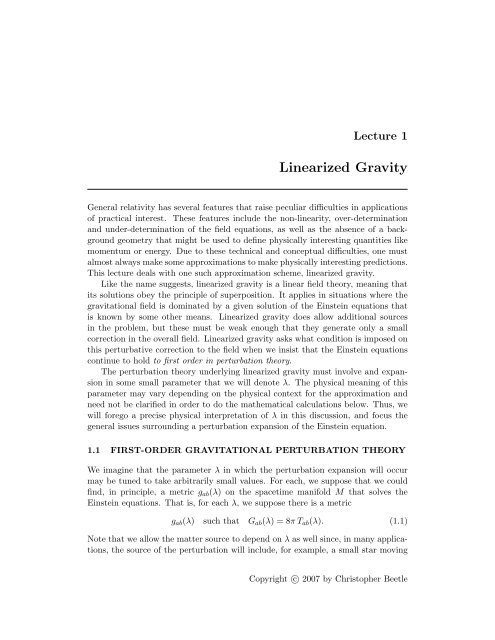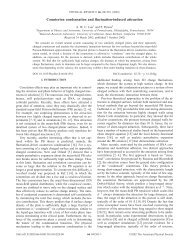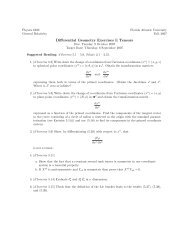Linearized Gravity
Linearized Gravity
Linearized Gravity
You also want an ePaper? Increase the reach of your titles
YUMPU automatically turns print PDFs into web optimized ePapers that Google loves.
Lecture 1<strong>Linearized</strong> <strong>Gravity</strong>General relativity has several features that raise peculiar difficulties in applicationsof practical interest. These features include the non-linearity, over-determinationand under-determination of the field equations, as well as the absence of a backgroundgeometry that might be used to define physically interesting quantities likemomentum or energy. Due to these technical and conceptual difficulties, one mustalmost always make some approximations to make physically interesting predictions.This lecture deals with one such approximation scheme, linearized gravity.Like the name suggests, linearized gravity is a linear field theory, meaning thatits solutions obey the principle of superposition. It applies in situations where thegravitational field is dominated by a given solution of the Einstein equations thatis known by some other means. <strong>Linearized</strong> gravity does allow additional sourcesin the problem, but these must be weak enough that they generate only a smallcorrection in the overall field. <strong>Linearized</strong> gravity asks what condition is imposed onthis perturbative correction to the field when we insist that the Einstein equationscontinue to hold to first order in perturbation theory.The perturbation theory underlying linearized gravity must involve and expansionin some small parameter that we will denote λ. The physical meaning of thisparameter may vary depending on the physical context for the approximation andneed not be clarified in order to do the mathematical calculations below. Thus, wewill forego a precise physical interpretation of λ in this discussion, and focus thegeneral issues surrounding a perturbation expansion of the Einstein equation.1.1 FIRST-ORDER GRAVITATIONAL PERTURBATION THEORYWe imagine that the parameter λ in which the perturbation expansion will occurmay be tuned to take arbitrarily small values. For each, we suppose that we couldfind, in principle, a metric g ab (λ) on the spacetime manifold M that solves theEinstein equations. That is, for each λ, we suppose there is a metricg ab (λ) such that G ab (λ) = 8π T ab (λ). (1.1)Note that we allow the matter source to depend on λ as well since, in many applications,the source of the perturbation will include, for example, a small star movingCopyright c○ 2007 by Christopher Beetle
2 Lecture 1: <strong>Linearized</strong> <strong>Gravity</strong>through a region of spacetime. We also suppose that the background metric˚g ab := g ab (λ = 0) (1.2)on the manifold M is known exactly, and solves the Einstein equation˚G ab = 8π ˚T ab (1.3)for a given source tensor field ˚T ab .We now imagine expanding the physical metric g ab (λ) as a power series in λabout λ = 0. The first-order coefficient in this expansion is given byġ ab := ∂g ab∂λ∣ (1.4)λ=0at each point of spacetime. Now, when we modify the spacetime geometry bychanging λ, we induce a change in the metric connection, and thus in the spacetimecurvature. Symbolically, we haveg ab (λ) ∇ a (λ) R abc d (λ) G ab (λ). (1.5)A randomly chosen modification g ab (λ) of the metric will not generally yield anEinstein tensor G ab (λ) equal to the modified stress-energy tensor T ab (λ), which weassume is given. Therefore, in perturbation theory, we must ask what constraint isimposed on the first-order metric perturbation ġ ab in the metric when we demandthat the Einstein equation continue to hold at first order:∂G ab∂λ∣ =: Ġ ab = 8π T ˙ ab := 8π ∂T abλ=0∂λ ∣ . (1.6)λ=0This constraint is the field equation of linearized gravity. To find it, we mustask how the first-order change ġ ab in the metric induces a first-order change Ġab inthe Einstein tensor.The Einstein tensor is determined by the Riemann curvature of the metric connection.Therefore, we must begin by sorting out the first-order correction to theconnection. This correction is the difference between two connections, ∇ a (ɛ) and∇ a (0), in the limit where ɛ goes to zero, and therefore is given by a tensor that wedenote ˙∇ ab c . For each λ, we will have∇ a (λ) g bc (λ) = 0. (1.7)The derivative of this relation with respect to λ may act either on the derivative operator∇ a —producing two terms, one for each covariant index of the metric tensor—oron the metric within. Since the right side does not depend on λ, we find˙∇ ab m g mc + ˙∇ ac m g bm + ∇ a ġ bc = 0. (1.8)
1.1. First-Order Gravitational Perturbation Theory 3We have left the λ-dependence of this result implicit and have not set λ = 0 justyet, even though this is the only relevant value of that parameter in the presentcalculation. In principle, one could take a second derivative with respect to λ tomove into second-order perturbation theory, though we will not do so here. Thisresult can be reorganized to give one constraint2 ˙∇ a(bc) = −∇ a ġ bc (1.9)on the connection perturbation ˙∇ ab c in terms of the metric perturbation ġ ab .Note that we are using the background metric to lower the index on the connectionperturbation here. A second constraint arises when we recall that ∇ a is meant tobe torsion-free for all λ. Thus, we find˙ T ab c = −2 ˙∇ [ab] c = 0. (1.10)These two constraints actually determine ˙∇ ab c uniquely. To see this, we lower theindex on the torsion constraint using the background metric and write˙∇ abc = −∇ a ġ bc − ˙∇ acb = −∇ a ġ bc − ˙∇ cab , (1.11)where we have used the metricity constraint in the first equality and the torsionconstraint in the second. The resulting connection perturbation on the right has itsindices cyclically permuted once compared to that on the left. Therefore, applyingthis result twice more gives˙∇ abc = −∇ a ġ bc − ( −∇ c ġ ab − ˙∇ bca)= −∇ a ġ bc + ∇ c ġ ab − ∇ b ġ ac − ˙∇ abc(1.12)The connection perturbation on the right now has its indices back in the originalperturbation, but occurs with a minus sign. Collecting these perturbations on theleft and dividing through by the factor of two gives the result˙∇ ab c = − 1 2 gcm ( 2 ∇ (a ġ b)m − ∇ m ġ ab)= −12 gcm ( 2 ∇ [b ġ m]a + ∇ a ġ bm), (1.13)where we have once again raised the last index with the background metric to putthe connection perturbation in its natural tensorial form. Note that the derivativeoperators on the right here are those compatible with the background metric.Calculating the perturbation in the Riemann tensor is slightly easier. Since themetric connections are all torsion-free, we haveR abc d ω d := 2 ∇ [a ∇ b] ω c (1.14)for each λ and for an arbitrary co-vector field ω a , which we may assume does not varywith λ. Differentiating both sides of this definition with respect to λ, we see thatthe derivative on the right may act on either of two copies of the connection. Acting
1.1. First-Order Gravitational Perturbation Theory 5the background metric g ab . It cannot denote both simply because of the minus signwe have found here and, in fact, we prefer the latter notation. Thus, we writedg abdλ := −ġab . (1.21)More generally, we denote with dots the perturbations of tensors with their naturalindex structures that arise in our theories. Those indices may subsequently be raisedor lowered using the background metric, but the definition of the dot operation refersto the natural index placement. Thus, for example, ˙∇abc above refers to the metricperturbation ˙∇ ab c with its last index lowered using the background metric and notto the λ-derivative of Γ ab m (λ) g mc (λ), where Γ ab c (λ) describes the difference between∇ a (λ) and some fixed coordinate connection ∂ a . The two are generally different.Returning to our discussion of the Einstein tensor, we now can writeĠ ab = − 1 2(−ġ ij g ab + g ij ġ ab)Rij + ( δ i a δ j b − 1 2 gij g ab)Ṙij . (1.22)Note the sign in the first term. To proceed, We must calculate the perturbation of theRicci tensor. Note that the identity operator used δd b used to contract the Riemannperturbation above passes through both the background covariant derivative ∇ a andthe λ-derivative. Thus, we can writeṘ ab = 2 ∇ [a ˙∇m]b m = −g mn ∇ [a(2 ∇[b ġ n]m] + ∇ m] ġ bn). (1.23)We have inserted our expression for the connection perturbation in the second equality,with the convention that the indices within the nested anti-symmetrization dono participate in the outer one. Expanding this gives four second-derivative termsfrom the first term, and two Riemann-curvature terms from the second:Ṙ ab = − 1 2 gmn ( ∇ a ∇ b ġ nm − ∇ a ∇ n ġ bm − ∇ m ∇ b ġ na + ∇ m ∇ n ġ ba+ R ambd ġ dn + R amnd ġ bd)(1.24)To show explicitly that the Ricci perturbation is symmetric in its two indices, whichit certainly must be, it will be convenient to commute the two derivative operatorsin the third term here so that it more closely resembles the second. This producestwo more curvature terms:Ṙ ab = − 1 2 gmn ( ∇ m ∇ n ġ ab − ∇ a ∇ n ġ mb − ∇ b ∇ m ġ na + ∇ a ∇ b ġ mn− R mbnd ġ da − R mbad ġ nd + R ambd ġ dn + R amnd ġ bd). (1.25)We now act with the inverse metric to get our final result:Ṙ ab = − 1 2 ∇ m ∇ m ġ ab + ∇ (a ∇ m ( ġ b)m − 1 2ġ g b)m)+ R(am ġ b)m − R am bn ġ mn . (1.26)This is the first-order perturbation in the Ricci tensor induced by a given first-ordermetric perturbation.
6 Lecture 1: <strong>Linearized</strong> <strong>Gravity</strong>When we insert the Ricii perturbation into the expression above for the Einsteinperturbation, note that the trace-reversal operator will pass through the derivativesin the first term here, and therefore that both sets of derivative terms can be writtensimply in terms of the trace-reversed metric perturbation 1h ab := ġ ab − 1 2ġ g ab with ġ := ġ m m . (1.27)In addition, note that we can replace the metric perturbations ġ mn with their tracereversalsh mn in the curvature terms since the extra terms are both proportionalto ġ R ab , and cancel. Likewise, we can replace the metric perturbations in thederivative of the trace-reversal operator with their trace-reversals because the extraterms cancel. This givesĠ ab = 1 2(h ij g ab − g ij h ab)Rij − 1 2 ∇ m ∇ m h ab+ ( δ i a δ j b − 1 2 gij g ab) (∇(i ∇ m h j)m + R (i m h j)m − R im j n h mn). (1.28)Finally, we can simplify this slightly by bringing the middle term in the final bracesout to cancel the first term, leavingĠ ab = − 1 2 ∇ m ∇ m h ab + G (a m h b)m+ ( δ i a δ j b − 1 2 gij g ab)(∇(i ∇ m h j)m − R im j n h mn). (1.29)Note that the second term in this final result involved the Einstein tensor of thebackground spacetime, which is determined by the background source distributionvia the Einstein equations. However, the last term involves the full Riemann tensor,which is not entirely determined by the background source.1.2 FIRST-ORDER POST-MINKOWSKI GRAVITYAn important application of the linearized formalism above arises when all gravitationalsources in a region of spacetime are weak. In this case, we can set˚g ab = η ab and ˚∇ a = ∂ a . (1.30)That is, we take the background metric to be the Minkowski metric, for which thecompatible connection is the flat inertial coordinate derivative. This causes thecurvature terms to drop out of the linearized field equation, and we can writeĠ ab = − 1 2 ∂ m ∂ m h ab + ∂ (a ∂ m h b)m − 1 2 η ab ∂ m ∂ n h mn = 8π ˙ T ab . (1.31)1 Our notation here is slightly non-standard. Our original metric perturbation ġ ab is often denotedh ab , a notation we use here to denote the trace-reversed perturbation. This trace-reversed object isconventionally denoted ¯h ab . That is, our ġ ab is their h ab , and our h ab is their ¯h ab . Hopefully, thiswill not cause too much confusion.
1.2. First-Order Post-Minkowski <strong>Gravity</strong> 7This is the first-order post-Minkowski field equation.There are many similarities between the post-Minkowski theory and Maxwelltheory on flat spacetime. For instance, if we take the divergence of both sides of thepost-Minkowski equation, we find that∂ a Ġ ab = − 1 2 ∂ m ∂ m ∂ a h ab + ∂ a ∂ (a ∂ m h b)m − 1 2 ∂ b ∂ m ∂ n h mn = 0 (1.32)on the left. Expanding the symmetrization in the middle term produces terms thatcancel the first and last exactly. Note that this is an identity; it does not rely onh ab satisfying the post-Minkowski field equation. This is not a coincidence. Indeed,the contracted Bianchi identity demands that∇ a G ab = g mn ∇ m G nb = 0 (1.33)for all λ. Taking a derivative of this with respect to λ implies thatg mn ∇ m Ġ nb + 2 g mn ˙∇m(n c G b)c − ġ mn ∇ m G nb = 0. (1.34)When the background spacetime satisfies the vacuum Einstein equations G mn =0, as Minkowski spacetime certainly does, the last two terms vanish. Therefore,the result above is really a manifestation of the contracted Bianchi identity in ourpost-Minkowski theory. Like that identity in the full theory, it implies that post-Minkowski gravity is over-determined. The source must satisfy∂ a ˙ T ab = 0 (1.35)for any solution of the field equation to exist. That is, for the post-Minkowski equationto be soluble, the energy and momentum of its source must be conserved. Thisresult seems a little troubling at first, since it evidently implies that, for example,particle sources of gravitational perturbations may only move inertially throughMinkowski spacetime. That is, they must move along straight lines. On the otherhand, many situations of interest would involve, for example, orbiting stars, whichcertainly do not move along inertial trajectories. Happily, there is no real problem,however. It is necessary only that the violation of this integrability condition for thepost-Minkowski theory be higher-order in perturbation theory. That is, for example,particle sources may accelerate, but that acceleration must be at least quadratic inthe perturbation parameter λ. Thus, we need not solve the integrability conditionexactly, only to the order of perturbation at which we work.The post-Minkowski field equations are also under-determined, again like theMaxwell equations. In this case, however, the degeneracy is not so obvious. Luckily,it does emerge readily from the general diffeomorphism freedom of general relativity.Consider two families of metricsg ab (λ) and ˜g ab (λ) := Φ(λ) · g ab (λ), (1.36)
8 Lecture 1: <strong>Linearized</strong> <strong>Gravity</strong>where Φ(λ) is a smooth, one-parameter family of diffeomorphisms of the manifoldM with Φ(0) the identity diffeomorphism. For each λ, as we have discussed, thesetwo metrics are physically equivalent; they differ only by how we label the pointsof spacetime. When we differentiate the second family of metrics with respect toλ, the derivative can either act on the metric or the diffeomorphism. In the lattercase, the effect is exactly a Lie derivative along the vector field φ a generating thediffeomorphisms Φ(λ):˙˜g ab = d dλ[Φ(λ) · gab (0) ] + Φ(0) · ġ ab = L φ η ab + ġ ab = ġ ab + 2 ∂ (a φ b) . (1.37)Thus, we can read off a guess at the action of a gauge transformation in post-Minkowski gravity on the metric perturbation ġ ab . We deduce thereby the correspondingaction on the trace-reversed perturbation:h ab ↦→ ˜h ab := h ab + 2 ∂ (a φ b) − η ab ∂ c φ c . (1.38)To check that this is indeed a gauge transformation, we insert the difference of thesetensors into the left side of the post-Minkowski field equation to find− 1 2 ∂ m ∂ m ( 2 ∂ (a φ b) − η ab ∂ c φ c)+ ∂ (a ∂ m ∂ b) φ m + ∂ (a ∂ m ∂ |m| φ b) − ∂ (a ∂ m ( η b)m ∂ c φ c)− 1 2 η ab ∂ m ∂ n ( 2 ∂ (m φ n) − η mn ∂ c φ c) = 0. (1.39)The two terms on the last line here differ by a sign and a factor of two, and togethercancel the last term on the first line. The first term on the first line likewise cancelsthe middle term on the second, and the first and last terms on the second line cancelone another. Thus, post-Minkowski gravity has a gauge ambiguity similar to thatof Maxwell theory, though the gauge transformations are generated by vector fieldsφ a rather than scalar functions ψ.






